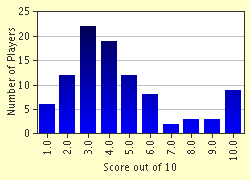Quiz Answer Key and Fun Facts
1. This scholarly book by Ignatius Donnelly created an Atlantean craze when it was first published in 1882. Still in print today, it attempts to lend credence to the legend of Atlantis by connecting it with religious scripture and myths from other world cultures. What is the name of the book?
2. Madam Helena Blavatsky, Russian medium and co-founder of The Theosophical Society, wrote this best-selling tome on spiritual arcana only a few years after she first emigrated to America in the late 1800's and learned to speak English. What is it?
3. Known to millions as "The Sleeping Prophet", self-educated Edgar Cayce was better at giving "life" readings for others than writing books for them to read. However, his close associate, Gina Cerminara wrote a very successful book about him and the past lives that he claimed to have lived. What was the book?
4. In the late 1950's, Robert Monroe was just an ordinary businessman when he began experiencing spontaneous out-of-body episodes, many of which reportedly took him to inter-dimensional locations. Now, not only is there an OBE research center in Virginia that bears his name, but the book he wrote about his experiences is still a "must-read" for anyone interested in studying the OBE phenomenon. What is the name of Robert Monroe's classic book?
5. While not technically a "book", this diary-like account of poltergiest activity in an 18th century English parsonage is notable not only for its wealth of detail, but for the impeccable social and moral credentials of its author. What famous English clergyman wrote about his and his family's experiences with the disruptive, unseen entity that plagued their home?
6. Not all books on paranormal subjects are somber, wordy tomes. The late J. Scott Rogo was a prolific author of many thoughtful yet entertaining books on the unseen world, but he is perhaps best remembered for his collaboration on a 1986 paperback classic that explores a very specific type of spirit communication. What is the name of this "fun" paranormal read?
7. In 1974, British pianist, Rosemary Brown published "Immortals By My Side", a best-selling account of her encounters with deceased luminaries of the arts world, including Beethoven, Liszt, George Bernard Shaw, and Einstein. What did Ms. Brown claim that these departed genuises wanted her to do?
8. John Keel's book, "The Mothman Prophecies" was recently made into a film starring Richard Gere. But although the film prompted a new wave of interest in the legenedary "Mothman" of West Virginia, many of the film's fans probably have never heard of Keel's other books on equally bizarre subjects. Which of the following is NOT a book written by paranormal author, John Keel?
9. Modern day fans of the early 20th century author, Charles Fort call themselves "Forteans" and are interested in bizarre phenomena that science ignores or cannot explain--such as reports of black rain, limestone, or dead fish falling from the sky. What is the name of Charles Fort's classic collection of such anamolous occurances?
10. One last, easy question. "Cosmic Consciousness," by 19th century author Richard Bucke, was an exploration of the sudden spiritual enlightenment that many individuals throughout history claimed to have experienced at various points in their lives. One of the most famous such individual was the Apostle Paul. What was Paul's name before he saw the "light" described by Bucke?
Source: Author
gretas
This quiz was reviewed by FunTrivia editor
Bruyere before going online.
Any errors found in FunTrivia content are routinely corrected through our feedback system.

